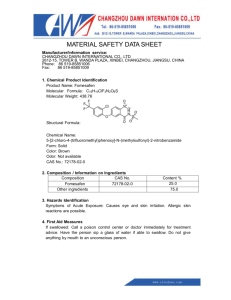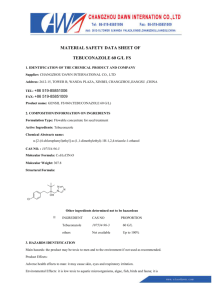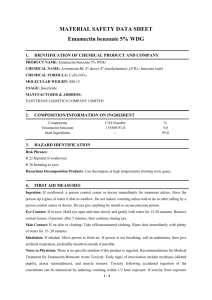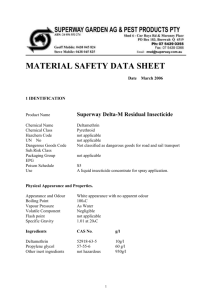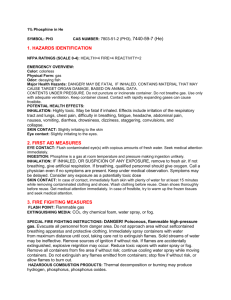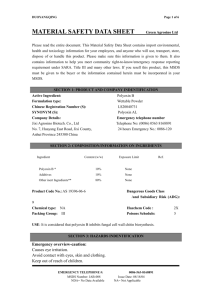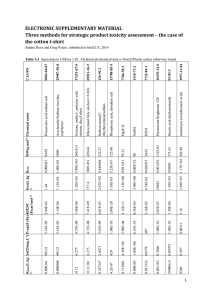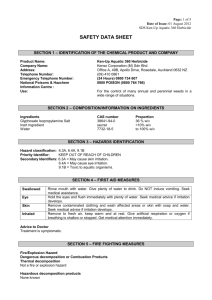swallowed landfill
advertisement
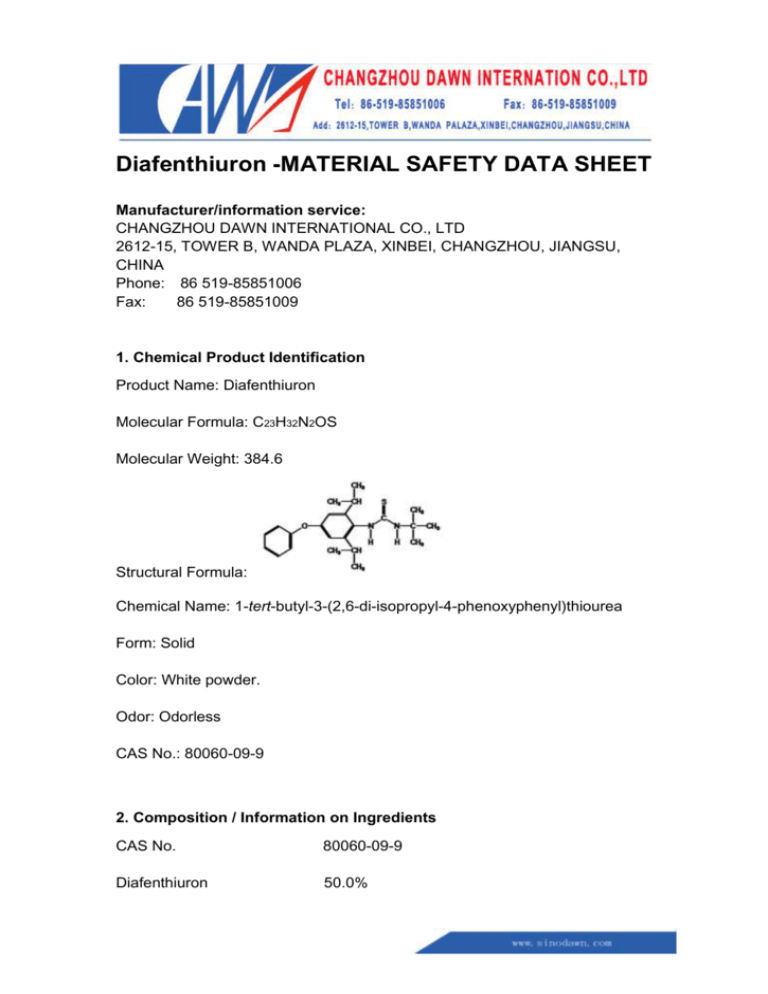
Diafenthiuron -MATERIAL SAFETY DATA SHEET Manufacturer/information service: CHANGZHOU DAWN INTERNATIONAL CO., LTD 2612-15, TOWER B, WANDA PLAZA, XINBEI, CHANGZHOU, JIANGSU, CHINA Phone: 86 519-85851006 Fax: 86 519-85851009 1. Chemical Product Identification Product Name: Diafenthiuron Molecular Formula: C23H32N2OS Molecular Weight: 384.6 Structural Formula: Chemical Name: 1-tert-butyl-3-(2,6-di-isopropyl-4-phenoxyphenyl)thiourea Form: Solid Color: White powder. Odor: Odorless CAS No.: 80060-09-9 2. Composition / Information on Ingredients CAS No. 80060-09-9 Diafenthiuron 50.0% Other ingredients 50.0% 3. Hazards Identification May cause sensitization by skin contact. Harmful: Danger of serious damage to health by prolonged exposure in contact with skin and if swallowed. 4. First Aid Measures In case of poisoning by any exposure route contact a doctor or Poisons Information Centre. Swallowed: If swallowed, contact medical care immediately. Eye: If product gets in eyes, flush eyes with running water for at least 15 minutes. Skin: If skin contact occurs, remove contaminated clothing and wash affected areas thoroughly with soap and water. Wash contaminated clothing before re-use. Inhaled: Move affected person to fresh air and keep at rest until recovered. 5. Fire-Fighting Measures This product is non-flammable. Extinguish warehouse and factory fires using fine-water spray or foam. When fighting a major fire wear a respirator. Do not allow fire-water to enter drains. 6. Accidental Release Measures In case of spillage it is important to take all steps necessary to: Avoid eye and skin contact. Avoid contamination of waterways. 7. Handling and Storage Store in tightly sealed original containers in a dry secure place away from fertilisers, seed, feed and food. Store out of direct sunlight. Keep out of reach of children, unauthorized persons and animals. 8. Exposure Controls/Personal Protection Engineering Controls: No special requirements. Product is used outdoors. Manual flagging is not permitted during aerial spraying of PEGASUS. Personal Protection: Will irritate the eyes and skin. Avoid contact with eyes and skin. Do not inhale spray mist. When opening the container, preparing the spray and using the prepared spray wear: Cotton overalls buttoned to the neck and wrist. A washable hat, and Elbow length PVC gloves. Wash hands after used. After each day’s use, wash gloves and contaminated clothing. Only use protective equipment bearing the mark . 9. Physical and Chemical Properties Specific gravity: 1.050 g/cm3 (at 20°C) Behaviour in water: Dispersible PH: 7.0 - 7.5 Melting point: 144.6-147.7°C. Vapor pressure: <2 × 10-3 mPa (25°C). Solubility at 25°C in: acetone 320 g/l, ethanol 43 g/l, n -hexane 9.6 g/l, n -octanol 26 g/l, toluene 330 g/l. 10. Stability and Reactivity Stability : stable at room temperature Corrosiveness: Non-corrosive Flammability: This product is non-flammable and non-combustible. 11. Toxicological Information ACUTE: Toxicity: This product is moderately hazardous (WHO Hazard Class II) Swallowed: LOW TOXICITY Tests indicate low toxicity following single doses of the undiluted product. (LD50 = 1950 mg/kg) Dermal absorption: LOW TOXICITY Tests indicate a low toxicity due to skin contact of the undiluted product. (LD50 = >4000 mg/kg) Irritation: Eye: Slight irritant. Skin: Slight irritant. Sensitization: Skin: Not a sensitiser. 12. Ecological and Ecotoxicological Information Toxicity on aquatic organisms LC50 (96h) : carp 0.0038mg/l Rainbow trout 0.0007mg/l Bluegill 0.0013mg/l Toxicity on birds Acute oral LD50 (mg/kg) : mallard and bobwhite quail >1500 LC50 (8days) ; mallard and bobwhite quail >1500mg/kg Toxicity on other organisms Bee LD50 (48h) : 2.1μg/bee(oral) , 1.5μg/bee(contact) 13. Disposal Considerations Dispose of empty, used containers by: Triple rinsing or preferably pressure rinsing containers with water. Add the rinsings to the spray tank. Do not dispose of undiluted chemicals on site. If recycling, replace cap and return clean containers to recycler or designated collection point. If not recycling, break, crush or puncture and bury empty containers in a local authority landfill. If no landfill is available, bury the containers below 500 mm in a disposal pit specifically marked and set up for this purpose clear of waterways, desirable vegetation and tree roots. Empty containers and product should not be burnt. 14. Transport Information Not applicable. 15. Regulatory Information Not applicable. 16. Other Information All information and instructions provided in this Material Safety Data Sheet (MSDS) are based on the current state of scientific and technical knowledge at the date indicated on the present MSDS and are presented in good faith and believed to be correct. This information applies to the product as such. In case of new formulations or mixes, it is necessary to ascertain that a new danger will not appear. It is the responsibility of persons on receipt of this MSDS to ensure that the information contained herein is properly read and understood by all people who may use, handle, dispose or in any way come in contact with the product. If the recipient subsequently produce formulations containing this product, it is the recipients sole responsibility to ensure the transfer of all relevant information from this MSDS to their own MSDS.

